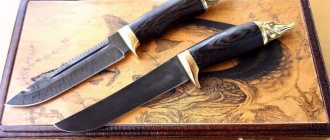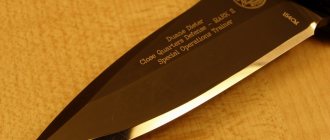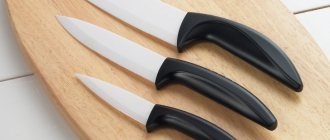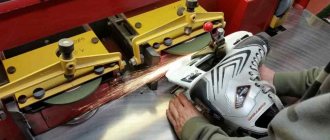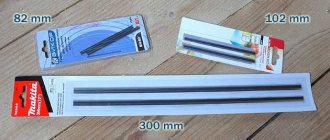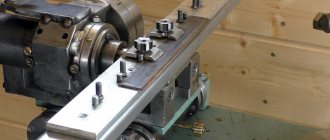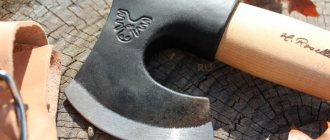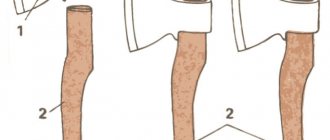I welcome everyone who is interested in simple ways to sharpen knives at home. Why did I decide to cover this particular topic? Turning to a web search, I found a number of recommendations for professional sharpening. These methods are well suited for sharpening serious items such as hunting or professional knives made from high-strength steel. However, I was unable to find a decent tutorial on how to properly sharpen a knife with a whetstone. Today I will tell you how you can simply restore the sharpness of an ordinary kitchen knife with a sharpening stone by hand.
To sharpen a regular kitchen knife, professional equipment is not required.
How to understand when it's time to sharpen a knife
Everyone uses knives in the kitchen every day. And if a professional Japanese chef is able to carry out all operations with one knife, then in our kitchens you can find a whole arsenal. This can be a historical collection of samples from past generations or elegant sets where representatives of all sizes and purposes are present. Most often there are inexpensive sets purchased for the occasion.
Professional sharpening methods require the use of special equipment, which is not always appropriate to keep on hand. There, sharpening is carried out on wheels with diamond dust or on a special water stone. But why resort to such difficulties? After all, in reality everything happens completely differently. I picked up a knife and found out that it needed sharpening. I would like to correct the situation immediately, within a short time.
Finding out that it’s time to sharpen a knife is not at all difficult - you set out to finely chop onions or tomatoes for a salad, but you can’t do it - the knife doesn’t want to cut, but simply crushes the vegetables or slides over them to no avail.
Types of knives and their purpose
Modern classification divides knives into the following categories:
- Combat. They are bladed weapons and are in service with the army as an addition to firearms. They are not intended for free sale and use.
- Tourist. Available for purchase, not prohibited from wearing, the handle and sheath are usually made of synthetic materials.
- Hunting. They have a varied form and purpose of use: work on cutting up hunted game, skinning, arranging a hunting area. Some types require permission to purchase and carry.
- Foldable or collapsible. A very common type, loved by all age categories of people. As the name suggests, the blade folds and the cutting edge fits into the handle. Some types are equipped with clips for attaching to a belt or pocket.
- Multitool A folding multifunctional knife with a set of tools - indispensable for travel and repairs. The standard sample includes: a small and large blade, pliers, screwdrivers, wrenches, a ruler, a hook, and scissors.
- Special purpose. A tool used in certain branches of human activity: medicine (scalpel), diving, Ministry of Emergency Situations, gardening.
- Campers or bivouacs. They are quite large in size and weight. Designed for setting up a tourist camp and clearing the area of the recreation area from bushes and small trees. An example is a machete or kukri. In practice, they easily replace an ax, but at the same time, they remain knives.
- Mark or sports knife for throwing. It is all-metal, without a cutting edge, and is designed to hit a target with a hand throw.
- Kitchen. Used for cooking, they come in a variety of shapes, sizes, thicknesses and blade configurations.
- Dining rooms. They have a certain shape with a rounded tip of the blade, the main purpose is to make eating easier.
- For survival. Positioned as assistants in extreme conditions. They have a number of features: the presence of a compass, a hollow handle that can accommodate a survival kit (a lighter, a fishing line with a sinker and a hook, a thread and a needle, an antiseptic, an antibiotic).
Cooking stage
Of course, if you are going to sharpen a knife at home, you want it to remain sharp for as long as possible. For this reason, I decided to share a simple, accessible method that, without much preparation, will help make a dull blade as sharp as possible without returning to this issue for a long time.
Take a regular boat-type block, although this shape is not necessary. You can perform this operation on any sharpening stone you have at hand. The method I propose will allow the operation to be carried out quickly and as simply as possible, and it does not matter which bars were used.
It doesn't really matter what grit the sharpener you choose is. It may well be either a smoother or a completely rough abrasive stone.
Remaining places
You can make a certain number of movements on each side, if it is more convenient.
- However, it is also possible to alternate sides by making one cut on one side of the blade, then flipping it over and making a cut on the other side.
- It's a good practice to finish with a few alternating movements, no matter what method we use.
Performance technique
I propose to consider a step-by-step sequence of actions that will tell you how to properly sharpen a knife using a sharpening stone.
- It is best to sharpen it on a wet stone in a sink near the water tap. To do this, moisten it with a soapy dish sponge. Then sharpening will occur smoothly, and there will be no jagged marks on the blade.
- To sharpen a kitchen knife according to all the rules, it must be moved along the sharpening stone, and not across. This will ensure the blade is sharpened to a razor sharpness. At the same time, how to direct the movement - away from yourself or towards yourself, depends on which direction the blade is tilted.
- It is necessary to constantly monitor the angle at which sharpening is carried out - the angle of inclination determines the shape of the resulting tip. The flatter the angle of inclination is chosen, the thinner the tip will be. This means that sharpening will be effective for a longer time.
- Next, you need to figure out which way to move the blade along the block. If the edge opposite the tip is tilted away from you, the knife must be pulled toward you and vice versa. The movement should imitate as if we are trying to scrape something off. Correctly move the knife along the block - in an arc.
At the very end of sharpening, it is better to make less effort. Using this rule, you can avoid the formation of burrs on the tip.
How to decide what is better to sharpen - a stone block or a diamond device. My answer is that correct double-sided sharpening of a dull knife can only be done with an emery stone. The sharpener that comes with the knives allows you to adjust the sharp blades from time to time, but cannot control the sharpening angle.
A diamond round sharpener is sometimes included in a set of knives.
Let's start sharpening the strokes
Holding the blade at the correct angle, draw down to sharpen the tip of the blade. Make sure that the stone runs the entire length of the blade so that its sharpness is evenly distributed.
We remember how many strokes we made, because it is very important to use the same number of strokes on the opposite side to get a sharp edge.
Cautions
Sharpening knives in the house is a man's job. In any case, that’s what our women say. For this reason, sooner or later you have to learn it. For beginners, I want to leave a warning - please make sure that your fingers remain off the edge of the sharpening stone, not in the path of the blade. A knife sliding across a soap bar leaves deep cuts.
You can learn all movements by moving from simple to complex. It’s worth practicing on small knives, and then moving on to larger ones.
It is very important to acquire the skill of keeping the angle of inclination constant. To do this, you need to fix the hand that holds the knife in one position.
For high-quality sharpening, you need to keep the block tilted away from you.
I was glad to be useful to everyone facing this problem. Share your experience with your friends on social networks - let them also learn about my technique. If sometimes difficulties arise in solving everyday issues, follow my publications. I will always tell you how to find a simple way out.
Main criteria when choosing a stone
Before purchasing a tool you must:
- Select abrasive material. In everyday life, ceramic products are more often used, for example, a boat-shaped block. A double-sided sharpener with a rough and smooth surface is often found. Diamond stones are rarely used in professional sharpening of kitchen knives. The high price limits the spread of natural abrasives.
- Pay attention to graininess. When sharpening, use bars with a grain size of 600-800 units. To polish the edge, bars marked 1500-2000 are used. Bars with a grain size of more than 2000 are intended for professional work.
- Consider the scope of use. The size of the block should exceed the length of the blade by 1.5-2 times.
Blade grinding using GOI paste
After we have sharpened the knife on a stone, the blade is polished using GOI paste. This procedure must be done, otherwise the knives will have to be sharpened much more often, the edge of the blade will be jagged, which will affect the deterioration of the cut. A knife with serrations will dull faster.
We take a board with leather and GOI paste, place a knife on it with the blade facing away from us and begin grinding. We carry it to the end, raise the blade, return it to its original state and start again. We do about 20-30 similar movements for one side.
Sand the other side. Periodically remove any remaining paste from the blade. After a good sanding, the edge of the blade should shine.
